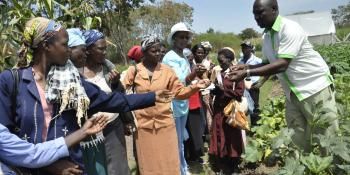Nyando’s climate-smart village scientist

Our profile on William Sang; a retired teacher and CCAFS champion farmer who is testing a number of climate-smart agriculture innovations on his three acre piece of land in rural Kenya.
We rummage our way on a rocky and dusty murram road leading to Tabet B village in Kericho County. This hilly area lies within the CGIAR Research Program on Climate Change, Agriculture and Food Security (CCAFS) climate-smart villages in Nyando. Common problems faced by this farming community include minimal and variable rainfall as well as land degradation resulting from surface run off. These challenges, together with many others, have continually made it harder for this community to be able to feed itself for a number of months each year. A few farmers are however rising above these challenges and are showing others the way.
William Sang is not your usual farmer, always keen on new innovations, he now has all his energy focused on climate-smart agriculture techniques. The United Nations Food Agriculture Organization (FAO) defines climate-smart agriculture as consisting of three main pillars: sustainably increasing agricultural productivity and incomes (food security); adapting and building resilience to climate change (adaptation); and reducing and/or removing greenhouse gas emissions (mitigation), where possible.
With just three acres of land, Sang’s rocky farm already functions like a self-sustaining machine. To reduce the effects of surface run off and soil erosion on his hilly piece of land, stone terraces and stone bunds have been skillfully constructed to guard against any further land degradation.
We find a sorghum demonstration plot on one corner where members of his farmer group – Tabet baseline – are testing the adaptability, vigor and productivity of various sorghum varieties that include Serena and Seredo. The trial is done in collaboration with the Kenya Agricultural Research Institute (KARI) and will ensure better sorghum varieties are available to the farming community in the area. In an adjacent plot, Sang has also planted finger millet, an improved variety developed by the International Crops Research Institute for the Semi-Arid Tropics (ICRISAT) and recently introduced in the area.
“In comparison to maize, finger millet does not require a lot of water and this variety is not vulnerable to pests and diseases” said Sang who is also trialing tissue culture bananas; another innovation from the International Institute of Tropical Agriculture (IITA) on his farm.
A short distance from the crops, a small piece of land has been cleared up and a rain gauge mounted at the center. It turns out Sang is also working with climate information scientists from the University of Reading in collaboration with Maseno University and the Kenya meteorological services through support by CCAFS. This project aims to improve access to climate information services which is critical for farm level decision making. Sang says following training, he is able to measure the amount of rainfall received and send the data via mobile messaging system to a central server. Thereafter, farmers get two – three day forecasts which help them to plan their farm activities including what crops to grow and in what season.
Read more on climate services: How can we help farmers better understand climate information

FARMER WILLIAM SANG IN HIS ROCKY PLOT OF ONION CROP. PHOTO: W. NINDO (VI AGROFORESTRY)
Another interesting innovation on Sang’s farm is a water pan measuring 3M x 2 ½ M x 1 ½ M and fitted with a liner to prevent seepage. He is able to harvest and store rain water for use during the dry season.
“My water pan has a capacity of 10,000 litres and when full, it supports watering of my crops and animals for upto 2 months into the dry season” Sang asserts.
By using a drip irrigation kit on his kitchen garden, Sang is able to not only grow vegetables for a longer period but also conserve water for other uses such as watering his improved livestock breed that include gala goats and red maasai sheep. Gala goats, recently introduced in the area mature faster and give lots of milk compared to the east African goats, common in the area. The red Maasai sheep on the other hand are resistant to diseases and tolerate heat very well.
Read more on the livestock initiative: Moulding climate champions; creating food secure communities
Sang grows high value fodder, including Napier and Rhodes grass separately on his farm and always has a steady supply for his livestock irrespective of the season.
As one of 50 champion farmers working with CCAFS and partners to test a portfolio of promising adaptation, mitigation and climate risk management interventions, sharing of lessons learnt is critical. On 27 June, 2014, Sang therefore hosted 1000 other farmers from his community during an annual farmer learning event held in his village. A retired teacher, Sang’s teaching experience was a resource that promoted learning among his neighbours.
CCAFS and other partners will continue working with farmers such as Sang and many others to create food secure communities.
Read about other climate champions in the Nyando Climate-Smart Villages:
Photostory: Kenya's climate-smart farms through a lens
Grandma Peris and her powerful plants
Smart farming yields fruit in Nyando
Video: Climate-smart farmer Peris Owiti has a demonstration plot for women
Video: Farmer story - crop rotation and diversification
Solomon Kilungu is a Communications Assistant while Philip Kimeli is a Research Technician. They both work for CCAFS EA. Editing by Vivian Atakos, Communications Specialist with CCAFS EA.



